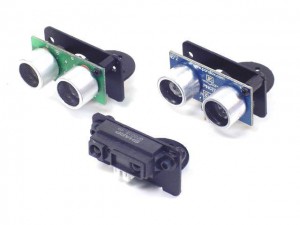After doing some more research on Arduino robotics, I found out that almost every robot is using some kind of a distance sensor. Probably I’m going to need one for my final project as well. I decided to look closer at these sensors and found two different types: Infrared Sensors and Ultrasonic Sensors (PING). Despite doing the same job (distance measuring and obstacle detection), they are very different. If I understand correctly, IR sensor is measuring light, while PING is measuring sound. I’m really confused which one is better and have a lot of (probably dumb) questions, such as:
- Is it ok to use an IR sensor in a well lit room, or it’s not going to work? From my experience I know that IR works better in darkness.
- The same about PING: will my robot go crazy if it’s too noisy in the room?
- What is the difference between analog and digital IR sensors?
- PING is twice as expensive as Sharp IR, does it mean that it’s much better?
I found this video, which is quite helpful, but it still doesn’t answer my questions:
It would be great, if we can go over different kinds of distance sensors in class. Another thing I’m really interested in, are motors. I can tell the difference between stepper and servo, but I absolutely don’t understand what is the Motor Shield for and do I need one to control servos or not? Also, how to choose the right servo for the project? There are so many out there and I have no idea which one do I need…





I found some interesting info with regards to your question about analog vs digital IR sensors and areas where they differ. From the article:
“Some object-detecting sensors adjust their detection threshold depending on the amount of ambient light and optical noise present in the environment. To avoid false detections in the presence of noise, the gain of the amplifier may adjust itself to such a low level that sensor responsiveness is affected. In low ambient light conditions, the sensor may increase its gain and make the receiver too sensitive, such that it will detect and respond to reflected or stray light.
…IR sensors with digital output eliminate these problems by featuring a fixed gain.”
Source: http://www.vishay.com/company/press/releases/2010/100628irsensors/
Thank you very much for the link! I’ve never heard about these particular sensors before. A 30m range is more than great!